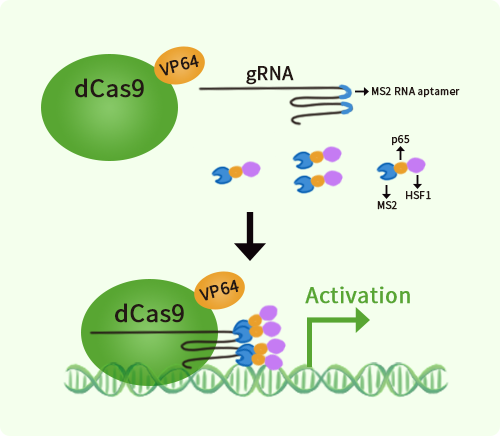Human RNF146 activation kit by CRISPRa
CAT#: GA113131
RNF146 CRISPRa kit - CRISPR gene activation of human ring finger protein 146
Find the corresponding CRISPRi Inhibitor Kit
USD 1,657.00
2 Weeks*
Specifications
| Product Data | |
| Format | 3 gRNAs (5ug each), 1 scramble ctrl (10ug) and 1 enhancer vector (10ug) |
| Symbol | RNF146 |
| Locus ID | 81847 |
| Kit Components | GA113131G1, RNF146 gRNA vector 1 in pCas-Guide-GFP-CRISPRa GA113131G2, RNF146 gRNA vector 2 in pCas-Guide-GFP-CRISPRa GA113131G3, RNF146 gRNA vector 3 in pCas-Guide-GFP-CRISPRa 1 CRISPRa-Enhancer vector, SKU GE100056 1 CRISPRa scramble vector, SKU GE100077 |
| Disclaimer | These products are manufactured and supplied by OriGene under license from ERS. The kit is designed based on the best knowledge of CRISPRa SAM technology. The efficiency of the activation can be affected by many factors, including nucleosome occupancy status, chromatin structure and the gene expression level of the target, etc. |
| Reference Data | |
| RefSeq | NM_001242844, NM_001242845, NM_001242846, NM_001242847, NM_001242848, NM_001242849, NM_001242850, NM_001242851, NM_001242852, NM_030963, NR_045102, NR_045103 |
| UniProt ID | Q9NTX7 |
| Synonyms | dJ351K20.1 |
| Summary | E3 ubiquitin-protein ligase that specifically binds poly-ADP-ribosylated (PARsylated) proteins and mediates their ubiquitination and subsequent degradation. May regulate many important biological processes, such as cell survival and DNA damage response. Acts as an activator of the Wnt signaling pathway by mediating the ubiquitination of PARsylated AXIN1 and AXIN2, 2 key components of the beta-catenin destruction complex. Acts in cooperation with tankyrase proteins (TNKS and TNKS2), which mediate PARsylation of target proteins AXIN1, AXIN2, BLZF1, CASC3, TNKS and TNKS2. Recognizes and binds tankyrase-dependent PARsylated proteins via its WWE domain and mediates their ubiquitination, leading to their degradation. Different ubiquitin linkage types have been observed: TNKS2 undergoes ubiquitination at 'Lys-48' and 'Lys-63', while AXIN1 is only ubiquitinated at 'Lys-48'. May regulate TNKS and TNKS2 subcellular location, preventing aggregation at a centrosomal location. Neuroprotective protein. Protects the brain against N-methyl-D-aspartate (NMDA) receptor-mediated glutamate excitotoxicity and ischemia, by interfering with PAR-induced cell death, called parthanatos. Prevents nuclear translocation of AIFM1 in a PAR-binding dependent manner. Does not affect PARP1 activation (By similarity). Protects against cell death induced by DNA damaging agents, such as N-methyl-N-nitro-N-nitrosoguanidine (MNNG) and rescues cells from G1 arrest. Promotes cell survival after gamma-irradiation. Facilitates DNA repair.[UniProtKB/Swiss-Prot Function] |
Documents
| Product Manuals |
| FAQs |
| SDS |
Resources
Other Versions
| SKU | Description | Size | Price |
|---|---|---|---|
| KN402306 | RNF146 - KN2.0, Human gene knockout kit via CRISPR, non-homology mediated. |
USD 1,657.00 |
{0} Product Review(s)
Be the first one to submit a review






























































































































































































































































 Germany
Germany
 Japan
Japan
 United Kingdom
United Kingdom
 China
China
